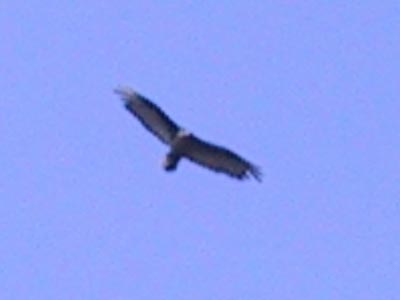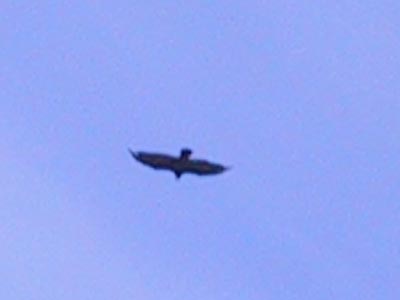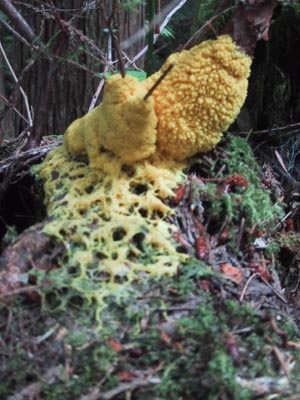
turkey vulture 1

turkey vulture 2
One swallow does not a summer make or so goes the old parable but when they start appearing en masse it makes it official. Undeterred by this year’s cool, wet summer, these winged sprites dart around me in figure 8’s and tight ellipses, schnarfling up the tiny insects disturbed by the progress of my sodden feet across the emerald dewiness of Pacific lawns. Locked into an hyper-accelerated life, they fly to eat and eat to fly. They mate, raise their young and then fatten themselves up for the long flight back to South America —all within the span of just three months. Yet in their grace and aerial spretzatura, swallows reveal nothing of their burden. Could they be enjoying themselves?
The mythical swallow-like martlet was said to have achieved such mastery of the air that it lost its feet, thereby freeing itself from all earthly bounds.
But for me, the true lords of the air are vultures. These majestic birds transform the putridity of death into poetry of the sky. Turkey vultures are an ubiquitous part of summer here, effortlessly spiralling up and down the air columns with barely a twitch of their wing feathers, Carrion is in abundant supply at the moment—the twisted corpses of yearling deer litter the roadsides, their stiff, cracked tongues splayed out of mouths gaped open in shock, trailing stalactites of dried spittle. Their noses, once black and glistening are now as dull and parched as abandoned wallets. Banished by their mothers to make way for the birth of new fawns, these yearlings have wandered dejectedly into the path of night-time cars like members of some Japanese high-school suicide cult. The despair of adolescence it would seem, knows no bounds.
As the first rays of morning sun begin to flood over the carnage of the night, the vultures swoop down to clean up the mess, swarming over the carcasses with a great flapping of wings, jostling to gain sufficient purchase from which to plunge their naked heads into the still steaming viscera. Those lower on the pecking order bide their time, hunched like scruffy black wigs on the dusty trees at the roadside, silently waiting their turns. The only sign of their impatience, an occasional nictitating of their cold eyes. A car approaches and the whole sullen flock lifts simultaneously in the sonic tide, those closest to the dead meat flapping perfunctorily up to the lowest branches. The car passes and each settles back to its place, like black wraith stars in a shifting constellation.
The vultures complete their grim task with amazing speed, returning repeatedly to gorge themselves, until in a few days there is nothing left but scattered bones and gristle. Were I to drop dead in the meadow in front of my house, I wouldn’t have to wait too long before they obliged me with a similar sky burial, my remains quickly reduced to squirts of guano deftly voided from the great blue heights and atomized by the warm summer breezes.
In Canada, at least, such bird-borne body disposal is illegal but this is not the case in India, where for centuries the Parsis have fed their dead to the vultures, in accordance with their Zoroastrian faith. Sadly the vulture population there is undergoing a catastrophic collapse. 98% of India’s vultures have disappeared in the last ten years — a rate of extinction even faster than that of the dodo.They are dying of kidney failure, which happens after they feed on the carcasses of livestock that have been treated with the common veterinary drug—diclofenac.
The effect of the vultures’ disappearance has rippled through the subcontinent, creating a glut of carrion, which in turn has led to an exponential increase in the population of feral, carrion-eating dogs. They increasingly attack humans, causing injury and spreading rabies. India now has the highest rate of rabies in the world, killing over 20,000 people each year. There is a demented kind of circularity to all of this that gives us an ominous foretaste of the Dante-esque effects we will routinely experience as the current mass extinction continues to run its course. If the loss of just a few species of vultures already leaves us to wring our hands while drowning in corpses and set upon by rabid dogs, what further delights might the future bring? Whatever is in store for us, we probably deserve it.
Slime molds, unlike humans, seem to be able to organize themselves to flow in the direction of their collective good. Without a brain, nervous system, or any other hard-wired command mechanism, individual slime mold cells will coalesce into a collective super-organism called a pseudoplasmodium when something important needs doing, like finding a better feeding ground. Once aggregated, the whole goopy assemblage then oozes across the forest floor until it arrives at its destination, where it comes to rest. The super-organism then disperses back into individuals who quickly melt away into the forest duff. This is all co-ordinated without any bosses or hierarchy and yet it works perfectly. Each individual slime mold cell is pretty much like every other, quite unremarkable, and yet in concert they are truly magnificent—an entity much greater than the sum of its parts. The secret to slime mold society is in the phenomenon of emergence—complexity emerging from simplicity. By harnessing the distributed cognition of individuals, the slime mold super-organism can solve sophisticated problems, even navigating its way through mazes that scientists set up for it. Not bad for a blob of slime. . .
In Philip K. Dick’s (1964) Clans of the Alphane Moon, a telepathic slime mold—Lord Running Clam— intervenes to help the protagonist, who has lost all hope and is about to commit suicide. Lord Running Clam fixes him up with a girlfriend and a job.

slime mold
Selfless in their selfishness, complex in their simplicity, perhaps we can take a few pointers from Lord Running Clam and his tribe. Our salvation may lie in emulating their style of adhocracy.
Lord Running Clam reminded us that —”No Terran is an island”— which should provide us with some solace. Of course he might have been referring to his prowess at telepathy.
Thanks to this summer’s rather damp start, conditions here have been perfect for slime mold viewing. I got to spend some quality time with one a couple of weeks ago. Its distributed self had coalesced into an orangey-yellow pseudoplasmodium, perched, as if ready to hold court, on a throne-like, mossy stump. In the presence of the slime mold, I felt like a penitent from a less advanced society, my existence still quaintly dependent on neurons and hierarchies. For its part, the slime mold remained inscrutable. Was it reading my mind?
Nature in its prelapsarian state continues to evaporate like a puddle on a midsummer highway, but beauty is everywhere, if you know how to find it—accented perhaps by the poignant sense of fin de siecle that now seems to permeate everything. I find it in the interstitial landscapes, so fetishized by Ballard and Gibson, increasingly the backdrop for our anomic lives. The vast edge city that sprawls across the Lower Mainland of British Columbia is such a case in point. It offers us a vista at once repellent and beguiling.
I love Richmond near the Vancouver Airport, particularly the vicinity of Bing Thom’s lego-like Aberdeen Centre, a sort of post-modern waiting hall at the foot of the great sky bridge to Asia. The trans-Pacific jets thunder overhead. In them, passengers are folding or unfolding their newspapers, getting ready for the long haul to Taipei or Narita or having just come from there, anticipating the sharp tang of New World air. The planes are so low, you can see the faces pressed against the windows. What are they thinking? On the ground, Shibuya hipsters and Korean Buddhist nuns head for the vast food court at Yaohan, while elderly white farmers sit in lawn chairs, staring uncomprehendingly at the freeway off-ramps, disgorging endless streams of traffic past their once quiet, ranch style homes.
Inside Aberdeen Centre’s atrium, an enormous fountain pullulates jets of water in time to a hollow-sounding recording of Enya, the computer-controlled hydraulics wheezing with effort. Asian shoppers sit impassively on its absurd bathtub-like rim, their backs to its failed spectacle. There is something so pathetic, clunky and yet beautiful in this fountain’s attempt to emulate . . . what ? . . . Nature ? It makes me weep. We have tried so hard and have failed so beautifully. . .

water feature


